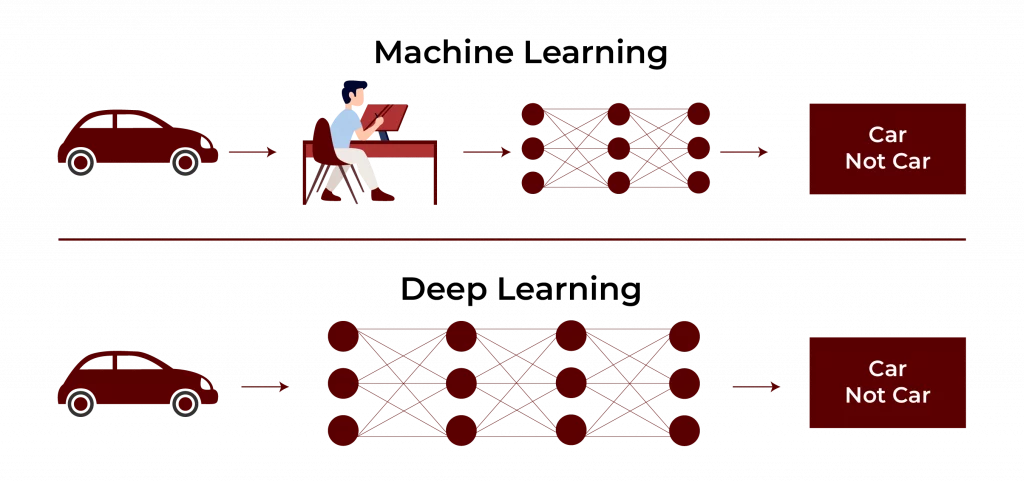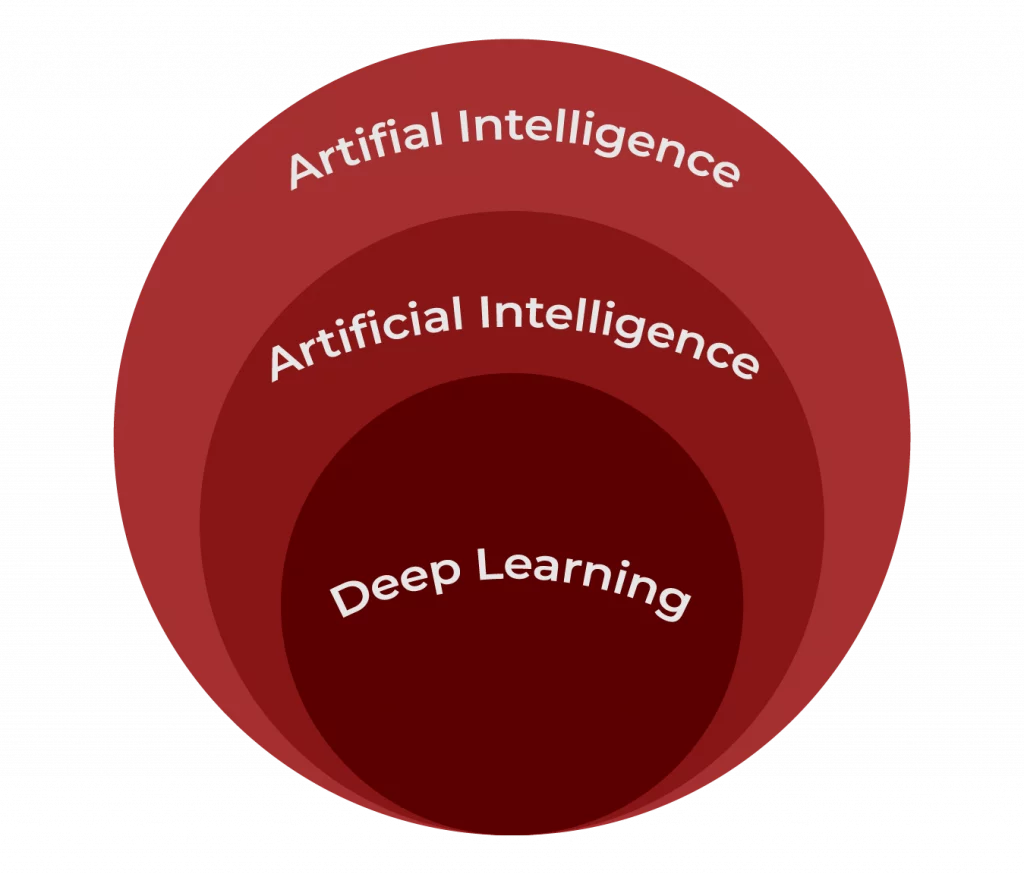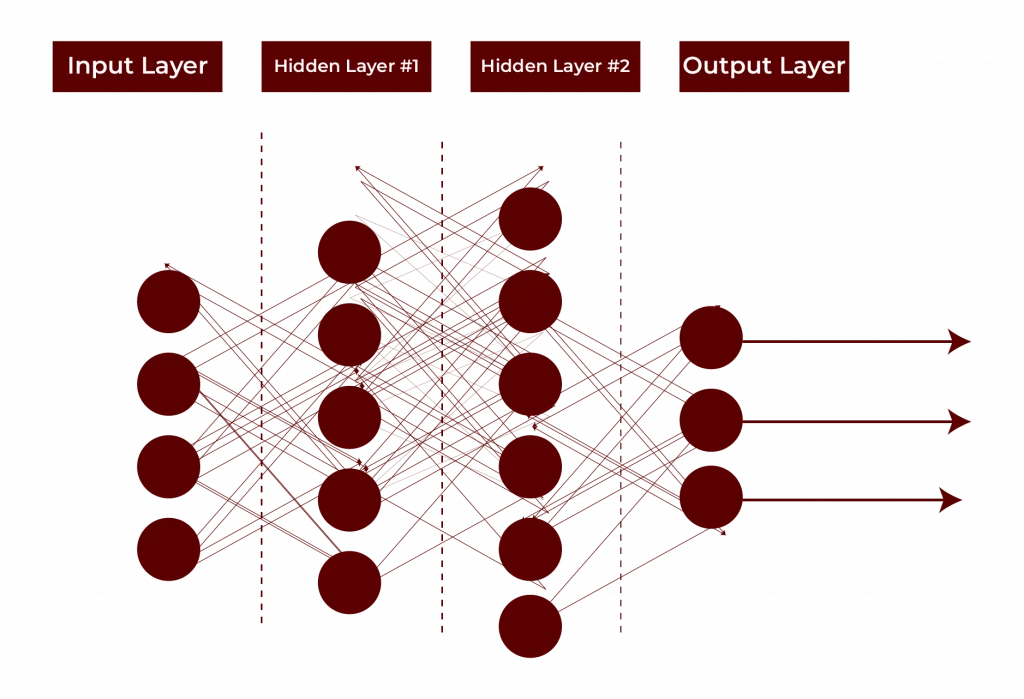In this world where the influence of Artificial Intelligence is growing day by day, I am sure that you might have heard some words like deep learning and machine learning. But can you ever imagine what they mean? Or are they almost the same, or perhaps there’s a little bit of difference between them?
Both deep learning and machine learning have their strengths, but they differ in fundamental ways. So, understanding the comparison of deep learning vs machine learning isn’t just useful; it’s crucial.
In this blog, we are going to break down these two concepts, compare their strengths, and look at when to use each for a specific application.
Deep Learning Vs Machine Learning: How They Differ from Each Other
Deep learning and machine learning are strong tools in the broad field of artificial intelligence (AI), yet they serve different purposes and excel at different tasks.
Machine learning is a method where computers are learned from data rather than programmed. It is a kind of method that focuses on the identification of patterns within structured data. For instance, it would look to determine patterns within customer records or sales data tables and then make predictions or decisions using the resultant patterns.
Machine learning systems learn from labelled examples and get better with time. It requires humans to provide structured data and help them understand what to look for. It relies on human guidance in defining which features are important in a dataset and is typically used for tasks involving clear, structured data.
On the other hand, deep learning is one type of machine learning. It’s based on complex structures called neural networks, which are inspired by the human brain. Deep learning models can deal with unstructured data – images, sounds, and text – with minimal or no human input. The opposite is the case in traditional machine learning.
High-dimensional data requires a high level of pattern understanding that can be handled by deep learning. It can deal with image recognition or speech analysis.


POSTGRADUATE PROGRAM IN
Data Science & AIML
Learn Data Science, AI & ML to turn raw data into powerful, predictive insights.
The Relationship Between AI, Machine Learning, and Deep Learning
Artificial Intelligence is the biggest layer and covers everything from rule-based systems that respond to if-then commands to complex autonomous learning models.
Machine Learning falls within AI as a specific way of enabling machines to learn from data patterns, improve accuracy with time, and is supported by statistical methods and basic algorithms that need human-guided data preparation.
Deep learning is placed inside machine learning, concentrating on complex neural networks with many layers – hence the term “deep”. The networks allow for deep learning systems to make sense of much more subtle patterns.
For example, where a machine learning model may detect whether someone’s email is spam, the deep learning model can easily note the sentiment in a customer’s message.
Think of it this way:
- AI is the goal: creating smart systems.
- Machine Learning is one approach to achieving that goal by using data-driven learning.
- Deep Learning is a specialised form of machine learning that uses layers of neural networks to perform high-level tasks with minimal human help.
Also Read: Data Science, Machine Learning, & Artificial Intelligence

Core Characteristics of Machine Learning: Algorithms, Data Needs, and Feature Engineering
Basically, machine learning is just about teaching a computer to recognise patterns without the dry knowledge of neural networks.
Machine learning relies on certain core characteristics to function well.
Let’s break these down.
Types of Machine Learning
- Supervised learning: It uses structured data to map a specific input to an output.
Some common supervised learning algorithms:
- Linear regression
- Polynomial regression
- K-nearest neighbours
- Naive Bayes
- Polynomial regression
- Decision trees
- Unsupervised learning: Unsupervised learning uses unstructured data to learn patterns.
Common unsupervised learning algorithms:
- Fuzzy means
- K-means clustering
- Hierarchical clustering
- Principal component analysis
- Partial least squares
- Reinforcement Learning: Reinforcement learning is defined as “learning by doing” via a series of trial and error experiments.
Reinforcement learning aims to train a machine to execute a task in an unpredictable environment. The environment provides the agent with observations and a reward, and the agent responds by performing actions. The reward determines how successful the activity is in terms of fulfilling the task goal.
Data Needs in Machine Learning
Structured data are necessary for machine learning. What we mean by structured data is data that’s been cleaned, labelled and organised.
For example, a machine learning model that predicts customer churn for a telecom company would work with structured datasets like:
| Customer Name | Age | Monthly Spend | Years with Company | Churned |
| Anjali Kapoor | 25 | 500 | 2 | Yes |
| Ramesh Patil | 40 | 750 | 5 | No |
| Sanya Verma | 33 | 620 | 3 | No |
| Aarav Mishra | 29 | 450 | 1 | Yes |
In this case, the model can easily identify patterns like age or spending habits that may affect a customer’s likelihood to leave.
But, structured data also limits machine learning to specific fields, unlike deep learning, which can handle more chaotic data types.
Feature Engineering: Building Better Models
Feature engineering is the step where we, as humans, tell the machine what’s important. It is a process of transforming raw data into some special features that machine learning systems can use to make predictions.
Suppose we’re trying to predict whether a car insurance policyholder will file a claim in the next year. The model doesn’t automatically know what factors matter most.
Here’s where feature engineering comes in.
In machine learning, we might highlight certain “features” of the data, such as:
- Age of Vehicle: Older vehicles might have higher chances of needing repairs.
- Driving History: A record of past claims could be a strong indicator of future claims.
- Geographic Location: If someone lives in an area with high accident rates, this might also impact claim probability.
We manually select and create these features to help the model recognise the patterns that matter.
Feature engineering often takes time and expertise because the machine is only as good as the features we give it.
This means machine learning needs human oversight at nearly every stage—from choosing the data to defining which parts of it are important.
In contrast, deep learning, as we’ll see, skips much of this manual setup by learning complex patterns on its own.
Unique Aspects of Deep Learning: Neural Networks, Data Requirements, and Self-Learning
What makes deep learning stand out?
While machine learning models depend on us to tell them what features to look at, deep learning does it differently.
Deep learning uses something called neural networks. At its core, a neural network takes data and passes it through multiple layers to figure out patterns on its own. These networks are like layers in an onion—they learn by going deep, layer by layer, which is why we call it “deep” learning.
No need to tell it that age or income is important. The network learns what matters.
Deep learning’s ability to learn without much human help makes it perfect for complex tasks. It can handle unstructured data, like photos, audio files, and text. That’s why we see it in image recognition or voice commands—it can pull out patterns that are hard to see.

Key Neural Network Types in Deep Learning
In deep learning, there are several types of neural networks, each good for different jobs.
Some of the most common types are:
- Convolutional Neural Networks (CNNs): Best for images, CNNs are used in facial recognition and photo analysis.
- Recurrent Neural Networks (RNNs): Perfect for data that changes over time, like stock prices or language translation.
- Transformers: Used widely in natural language processing, transformers power systems like chatbots and language models.
These networks give deep learning flexibility.
They adjust to handle everything from detecting objects in a video to translating languages. And unlike traditional machine learning, deep learning doesn’t rely on us to build features.
It creates its own “map” of important data as it learns.
Data Demands for Deep Learning
The more data we have, the better it performs.
Imagine trying to teach someone to recognise different bird species. If you only show them three photos, they’ll struggle. But with thousands of images, they’ll get good at spotting different birds quickly.
Deep learning models need the same thing.
They work best with lots of data and struggle without it.
This makes deep learning useful for big tasks with plenty of data, like predicting traffic from satellite images or understanding the sentiment in thousands of social media posts.
If we’re short on data, machine learning might be a better choice. But when data is abundant, deep learning models can dive in, finding patterns that simpler models miss.
Also Read: Top Deep Learning Interview Questions and Answers

82.9%
of professionals don't believe their degree can help them get ahead at work.
Deep Learning Vs Machine Learning: Major Differences in Technology and Use Cases
Let’s compare deep learning vs machine learning and break it down into some specific areas.
Data Volume and Structure
- Machine Learning: Works well with smaller, structured datasets, like tables of customer data.
- Deep Learning: Thrives on large, unstructured datasets, like images, audio, and long texts.
Machine learning models need data that’s prepped and labelled. Deep learning can take raw data and extract meaning without much cleanup.
This opens up deep learning to a wider range of tasks.
Computational Power and Hardware Requirements
- Machine Learning: Usually runs on standard computers or CPUs.
- Deep Learning: Needs high-performance GPUs or TPUs due to complex computations.
Training a deep learning model can be like running a mini supercomputer. It’s faster and more efficient with specialised hardware, which can add costs.
In short, machine learning runs on simpler setups, while deep learning needs advanced tech to reach its potential.
Feature Engineering and Automation
- Machine Learning: Relies on humans to choose important features.
- Deep Learning: Automatically learns what features matter without our input.
Machine learning needs us to guide it, but deep learning handles the details itself.
This independence makes deep learning perfect for complex problems where feature selection isn’t clear-cut.
Training Duration and Operational Efficiency
- Machine Learning: Trains faster and can run on smaller machines.
- Deep Learning: Takes longer to train, but less human help once it’s set up.
Deep learning needs time and data to find those complex patterns. But once trained, it’s efficient at recognising similar patterns in new data.
Accuracy, Interpretability, and Suitability
- Machine Learning: Easier to explain, ideal for problems needing clear answers.
- Deep Learning: Often more accurate for complex tasks, but operates as a “black box” with results that are hard to explain.
For tasks where understanding the “why” matters, like in finance, machine learning might be better. If we’re fine with high accuracy but less clarity, deep learning works well for things like image recognition.
Deep Learning Vs Machine Learning: Real-world Applications
Applications of Machine Learning in Real-world Scenarios
- Fraud Detection in Financial Services
- Customer Segmentation in Marketing
- Product Quality Assurance in Manufacturing
Applications of Deep Learning in Real-World Scenarios
- Medical Imaging Analysis
- Speech Recognition in Customer Service
- Autonomous Vehicles
Deep Learning Vs Machine Learning: Which One to Choose for Your Needs
When should you choose machine learning, and when does deep learning make more sense?
Here’s a quick guide to help you decide.
Data Availability and Complexity
If you’re working with small, structured datasets, like customer purchase records or employee attendance, machine learning is a good fit. Machine learning performs well without tons of data.
But for tasks that involve vast, unstructured data—such as photos, audio, or extensive text—deep learning takes the lead. Its algorithms thrive on large data volumes.
Computational Resources
Machine learning models can run on regular computers. They don’t need high-end graphics processing units (GPUs) to operate.
Deep learning models, on the other hand, demand power. They work best with advanced GPUs or cloud-based platforms to handle their calculations. If your project can support this, deep learning may be a strong option.
Problem Complexity
Machine learning is ideal for simpler, rule-based tasks where interpretability matters. For example, if you’re building a model to predict loan approval, machine learning’s transparency can be useful.
But when your task involves understanding complex relationships, such as translating languages or recognising faces, deep learning takes the stage.
Also Read: Top Machine Learning Interview Questions & Answers [2024]
Conclusion
To sum up, the choice between deep learning vs machine learning depends on your data, your needs, and your goals.
On tasks such as customer segmentation and fraud detection, where one has structured data, machine learning is ideal, deriving accuracy with low resources.
Deep learning, by contrast, handles complex and unstructured data, excelling in tasks such as image recognition and speech processing, where it uncovers intricate patterns on its own.
The choice between them hinges on data type, computational power, and problem complexity. This understanding helps businesses and developers select the right approach for impactful and efficient AI-driven solutions.
If you want to go deeper into Data Science, AI, and ML, then consider going deep by joining the Hero Vired Integrated Programme in Data Science, AI & ML. Upon completion of this comprehensive programme, you will have the in-depth knowledge of machine learning, deep learning, and data science to solve real-life problems.
Why does deep learning need more data than machine learning?
What hardware do I need for deep learning?
Is deep learning always more accurate than machine learning?
Which is more suitable for my business: machine learning or deep learning?
Updated on November 11, 2024
